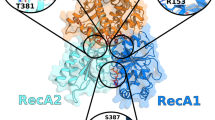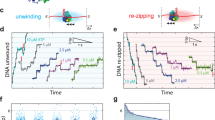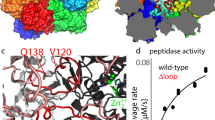Abstract
SecA is a helicase-like motor that couples ATP hydrolysis with the translocation of extracytoplasmic protein substrates. As in most helicases, this process is thought to occur through nucleotide-regulated rigid-body movement of the motor domains. NMR, thermodynamic and biochemical data show that SecA uses a novel mechanism wherein conserved regions lining the nucleotide cleft undergo cycles of disorder-order transitions while switching among functional catalytic states. The transitions are regulated by interdomain interactions mediated by crucial 'arginine finger' residues located on helicase motifs. Furthermore, we show that the nucleotide cleft allosterically communicates with the preprotein substrate–binding domain and the regulatory, membrane-inserting C domain, thereby allowing for the coupling of the ATPase cycle to the translocation activity. The intrinsic plasticity and functional disorder-order folding transitions coupled to ligand binding seem to provide a precise control of the catalytic activation process and simple regulation of allosteric mechanisms.
This is a preview of subscription content, access via your institution
Access options
Subscribe to this journal
Receive 12 print issues and online access
$189.00 per year
only $15.75 per issue
Buy this article
- Purchase on Springer Link
- Instant access to full article PDF
Prices may be subject to local taxes which are calculated during checkout








Similar content being viewed by others
References
Vrontou, E. & Economou, A. Structure and function of SecA, the preprotein translocase nanomotor. Biochim. Biophys. Acta 1694, 67–80 (2004).
Driessen, A.J., Manting, E.H. & van der Does, C. The structural basis of protein targeting and translocation in bacteria. Nat. Struct. Biol. 8, 492–498 (2001).
Mori, H. & Ito, K. The Sec protein-translocation pathway. Trends Microbiol. 9, 494–500 (2001).
Osborne, A.R., Rapoport, T.A. & van den Berg, B. Protein translocation by the Sec61/Secy channel. Annu. Rev. Cell Dev. Biol. 21, 529–550 (2005).
Hunt, J.F. et al. Nucleotide control of interdomain interactions in the conformational reaction cycle of SecA. Science 297, 2018–2026 (2002).
Sharma, V. et al. Crystal structure of Mycobacterium tuberculosis SecA, a preprotein translocating ATPase. Proc. Natl. Acad. Sci. USA 100, 2243–2248 (2003).
Sianidis, G. et al. Cross-talk between catalytic and regulatory elements in a DEAD motor domain is essential for SecA function. EMBO J. 20, 961–970 (2001).
Caruthers, J.M. & McKay, D.B. Helicase structure and mechanism. Curr. Opin. Struct. Biol. 12, 123–133 (2002).
Tanner, N.K. & Linder, P. DExD/H box RNA helicases: from generic motors to specific dissociation functions. Mol. Cell 8, 251–262 (2001).
Story, R.M., Weber, I.T. & Steitz, T.A. The structure of the E. coli recA protein monomer and polymer. Nature 355, 318–325 (1992).
Papanikou, E. et al. Helicase Motif III in SecA is essential for coupling preprotein binding to translocation ATPase. EMBO Rep. 5, 807–811 (2004).
Delagoutte, E. & von Hippel, P.H. Helicase mechanisms and the coupling of helicases within macromolecular machines. Part I: structures and properties of isolated helicases. Q. Rev. Biophys. 35, 431–478 (2002).
Rocak, S. & Linder, P. DEAD-box proteins: the driving forces behind RNA metabolism. Nat. Rev. Mol. Cell Biol. 5, 232–241 (2004).
Baud, C. et al. Allosteric communication between signal peptides and the SecA protein DEAD motor ATPase domain. J. Biol. Chem. 277, 13724–13731 (2002).
Papanikou, E. et al. Identification of the preprotein binding domain of SecA. J. Biol. Chem. 280, 43209–43217 (2005).
Economou, A. & Wickner, W. SecA promotes preprotein translocation by undergoing ATP-driven cycles of membrane insertion and deinsertion. Cell 78, 835–843 (1994).
Karamanou, S. et al. A molecular switch in SecA protein couples ATP hydrolysis to protein translocation. Mol. Microbiol. 34, 1133–1145 (1999).
Vrontou, E., Karamanou, S., Baud, C., Sianidis, G. & Economou, A. Global co-ordination of protein translocation by the SecA IRA1 switch. J. Biol. Chem. 279, 22490–22497 (2004).
Lill, R., Dowhan, W. & Wickner, W. The ATPase activity of SecA is regulated by acidic phospholipids, SecY, and the leader and mature domains of precursor proteins. Cell 60, 271–280 (1990).
Triplett, T.L. et al. Functional signal peptides bind a soluble N-terminal fragment of SecA and inhibit its ATPase activity. J. Biol. Chem. 276, 19648–19655 (2001).
Schliwa, M. & Woehlke, G. Molecular motors. Nature 422, 759–765 (2003).
Ye, J., Osborne, A.R., Groll, M. & Rapoport, T.A. RecA-like motor ATPases–lessons from structures. Biochim. Biophys. Acta 1659, 1–18 (2004).
Gai, D., Zhao, R., Li, D., Finkielstein, C.V. & Chen, X.S. Mechanisms of conformational change for a replicative hexameric helicase of SV40 large tumor antigen. Cell 119, 47–60 (2004).
Mancini, E.J. et al. Atomic snapshots of an RNA packaging motor reveal conformational changes linking ATP hydrolysis to RNA translocation. Cell 118, 743–755 (2004).
Velankar, S.S., Soultanas, P., Dillingham, M.S., Subramanya, H.S. & Wigley, D.B. Crystal structures of complexes of PcrA DNA helicase with a DNA substrate indicate an inchworm mechanism. Cell 97, 75–84 (1999).
Korolev, S., Hsieh, J., Gauss, G.H., Lohman, T.M. & Waksman, G. Major domain swiveling revealed by the crystal structures of complexes of E. coli Rep helicase bound to single-stranded DNA and ADP. Cell 90, 635–647 (1997).
Karpowich, N. et al. Crystal structures of the MJ1267 ATP binding cassette reveal an induced-fit effect at the ATPase active site of an ABC transporter. Structure 9, 571–586 (2001).
Wang, J. Nucleotide-dependent domain motions within rings of the RecA/AAA(+) superfamily. J. Struct. Biol. 148, 259–267 (2004).
Savvides, S.N. et al. VirB11 ATPases are dynamic hexameric assemblies: new insights into bacterial type IV secretion. EMBO J. 22, 1969–1980 (2003).
Bernstein, D.A., Zittel, M.C. & Keck, J.L. High-resolution structure of the E. coli RecQ helicase catalytic core. EMBO J. 22, 4910–4921 (2003).
Shi, H., Cordin, O., Minder, C.M., Linder, P. & Xu, R.M. Crystal structure of the human ATP-dependent splicing and export factor UAP56. Proc. Natl. Acad. Sci. USA 101, 17628–17633 (2004).
Xing, X. & Bell, C.E. Crystal structures of Escherichia coli RecA in complex with MgADP and MnAMP-PNP. Biochemistry 43, 16142–16152 (2004).
Osborne, A.R., Clemons, W.M., Jr. & Rapoport, T.A. A large conformational change of the translocation ATPase SecA. Proc. Natl. Acad. Sci. USA 101, 10937–10942 (2004).
Chou, Y.T., Swain, J.F. & Gierasch, L.M. Functionally significant mobile regions of Escherichia coli SecA ATPase identified by NMR. J. Biol. Chem. 277, 50985–50990 (2002).
Caruthers, J.M., Johnson, E.R. & McKay, D.B. Crystal structure of yeast initiation factor 4A, a DEAD-box RNA helicase. Proc. Natl. Acad. Sci. USA 97, 13080–13085 (2000).
Story, R.M., Li, H. & Abelson, J.N. Crystal structure of a DEAD box protein from the hyperthermophile Methanococcus jannaschii. Proc. Natl. Acad. Sci. USA 98, 1465–1470 (2001).
Zhao, R., Shen, J., Green, M.R., MacMorris, M. & Blumenthal, T. Crystal structure of UAP56, a DExD/H-box protein involved in pre-mRNA splicing and mRNA export. Structure 12, 1373–1381 (2004).
Volkman, B.F., Lipson, D., Wemmer, D.E. & Kern, D. Two-state allosteric behavior in a single-domain signaling protein. Science 291, 2429–2433 (2001).
Kalodimos, C.G. et al. Structure and flexibility adaptation in nonspecific and specific protein-DNA complexes. Science 305, 386–389 (2004).
Akke, M. NMR methods for characterizing microsecond to millisecond dynamics in recognition and catalysis. Curr. Opin. Struct. Biol. 12, 642–647 (2002).
Cliff, M.J., Williams, M.A., Brooke-Smith, J., Barford, D. & Ladbury, J.E. Molecular recognition via coupled folding and binding in a TPR domain. J. Mol. Biol. 346, 717–732 (2005).
Baker, B.M. & Murphy, K.P. Evaluation of linked protonation effects in protein binding reactions using isothermal titration calorimetry. Biophys. J. 71, 2049–2055 (1996).
Spolar, R.S. & Record, M.T., Jr. Coupling of local folding to site-specific binding of proteins to DNA. Science 263, 777–784 (1994).
Bruzzese, F.J. & Connelly, P.R. Allosteric properties of inosine monophosphate dehydrogenase revealed through the thermodynamics of binding of inosine 5′-monophosphate and mycophenolic acid. Temperature dependent heat capacity of binding as a signature of ligand-coupled conformational equilibria. Biochemistry 36, 10428–10438 (1997).
Grucza, R.A., Futterer, K., Chan, A.C. & Waksman, G. Thermodynamic study of the binding of the tandem-SH2 domain of the Syk kinase to a dually phosphorylated ITAM peptide: evidence for two conformers. Biochemistry 38, 5024–5033 (1999).
Kumaran, S., Grucza, R.A. & Waksman, G. The tandem Src homology 2 domain of the Syk kinase: a molecular device that adapts to interphosphotyrosine distances. Proc. Natl. Acad. Sci. USA 100, 14828–14833 (2003).
den Blaauwen, T., Fekkes, P., de Wit, J.G., Kuiper, W. & Driessen, A.J. Domain interactions of the peripheral preprotein translocase subunit SecA. Biochemistry 35, 11994–12004 (1996).
Fak, J.J. et al. Nucleotide exchange from the high-affinity ATP-binding site in SecA is the rate-limiting step in the ATPase cycle of the soluble enzyme and occurs through a specialized conformational state. Biochemistry 43, 7307–7327 (2004).
Bourne, H.R. G proteins. The arginine finger strikes again. Nature 389, 673–674 (1997).
Crampton, D.J., Guo, S., Johnson, D.E. & Richardson, C.C. The arginine finger of bacteriophage T7 gene 4 helicase: role in energy coupling. Proc. Natl. Acad. Sci. USA 101, 4373–4378 (2004).
Or, E., Navon, A. & Rapoport, T. Dissociation of the dimeric SecA ATPase during protein translocation across the bacterial membrane. EMBO J. 21, 4470–4479 (2002).
Kourtz, L. & Oliver, D. Tyr-326 plays a critical role in controlling SecA-preprotein interaction. Mol. Microbiol. 37, 1342–1356 (2000).
Schmidt, M., Ding, H., Ramamurthy, V., Mukerji, I. & Oliver, D. Nucleotide binding activity of SecA homodimer is conformationally regulated by temperature and altered by prlD and azi mutations. J. Biol. Chem. 275, 15440–15448 (2000).
Ramamurthy, V., Dapic, V. & Oliver, D. secG and temperature modulate expression of azide-resistant and signal sequence suppressor phenotypes of Escherichia coli secA mutants. J. Bacteriol. 180, 6419–6423 (1998).
Liu, D., Windsor, W.T. & Wyss, D.F. Double-stranded DNA-induced localized unfolding of HCV NS3 helicase subdomain 2. Protein Sci. 12, 2757–2767 (2003).
Acknowledgements
We wish to thank L. Gierasch for helpful discussions, F. Jordan for the use of the VP-ITC, Y. Papanikolau and K. Petratos for sharing data before publication, S. Papanikou and B. Pozidis for help with chromatography and R. Monteiro, A. Khan and M. Vougioukalaki for experiments performed during their undergraduate training. Initial experiments were supported by an EU large-scale facility grant to SON-NMR Utrecht, The Netherlands. Research was supported by a Scientist Development Grant from the American Heart Association (to C.G.K.), a Johnson & Johnson Discovery Award (to C.G.K.), a Rutgers Busch grant (to C.G.K.), grants from the EU (RTN1-1999-00149, QLK3-CT-2000-00082 and QLK3-CT-2000-00082; to A.E), Pfizer, Inc. and grants from the Greek General Secretariat of Research (01AKMON46 and PENED03ED623; to A.E).
Author information
Authors and Affiliations
Corresponding author
Ethics declarations
Competing interests
The authors declare no competing financial interests.
Supplementary information
Supplementary Fig. 1
Secondary structural elements of IRA2 in solution (PDF 226 kb)
Supplementary Fig. 2
ITC traces and binding isotherms of nucleotide interaction with SecA and SecAΔC (PDF 320 kb)
Supplementary Fig. 3
Genetic complementation assay for secA and secA-D649A genes (PDF 176 kb)
Supplementary Fig. 4
Thermodynamic analysis of nucleotide interaction with SecA, SecA-R574K and SecAΔC (PDF 204 kb)
Supplementary Fig. 5
Effect of 'arginine fingers' mutation on SecA properties (PDF 201 kb)
Supplementary Fig. 6
1H-15N HSQC spectra of PBD, SecAΔC-ΔIRA2 and effect of ADP binding to SecAΔC on PBD (PDF 402 kb)
Rights and permissions
About this article
Cite this article
Keramisanou, D., Biris, N., Gelis, I. et al. Disorder-order folding transitions underlie catalysis in the helicase motor of SecA. Nat Struct Mol Biol 13, 594–602 (2006). https://doi.org/10.1038/nsmb1108
Received:
Accepted:
Published:
Issue Date:
DOI: https://doi.org/10.1038/nsmb1108
This article is cited by
-
Protein Transport Across the Bacterial Plasma Membrane by the Sec Pathway
The Protein Journal (2019)
-
Protein export through the bacterial Sec pathway
Nature Reviews Microbiology (2017)
-
Large interdomain rearrangement triggered by suppression of micro- to millisecond dynamics in bacterial Enzyme I
Nature Communications (2015)
-
Emerging themes in SecA2-mediated protein export
Nature Reviews Microbiology (2012)
-
Messing up disorder: how do missense mutations in the tumor suppressor protein APC lead to cancer?
Molecular Cancer (2011)



